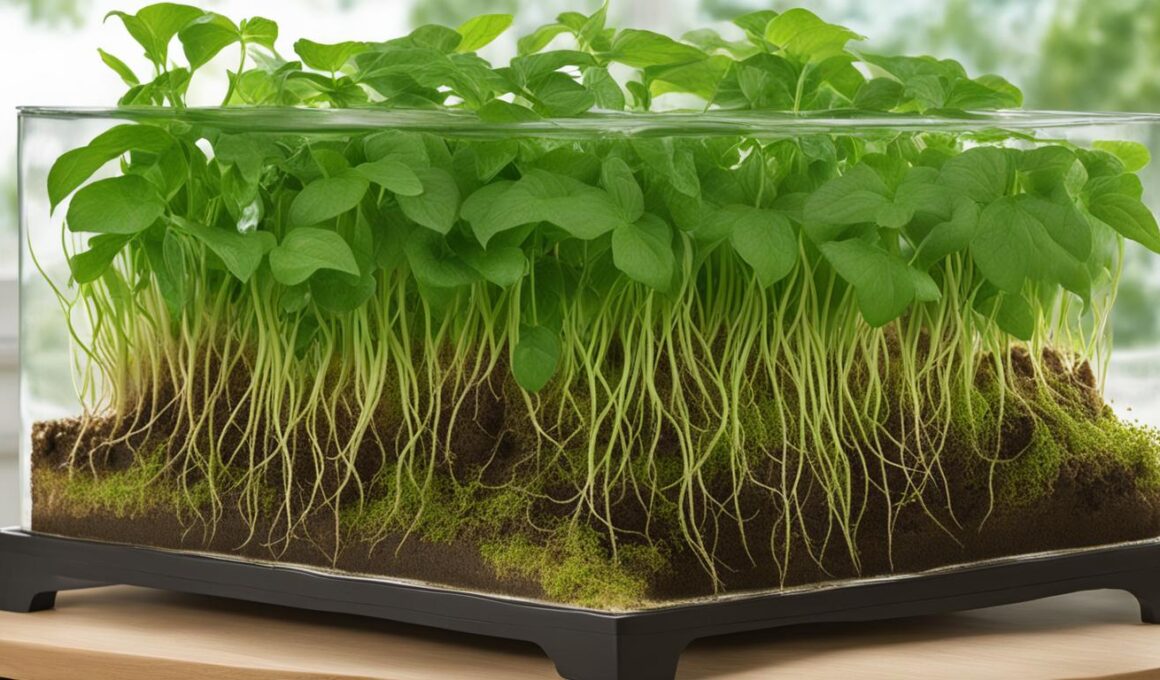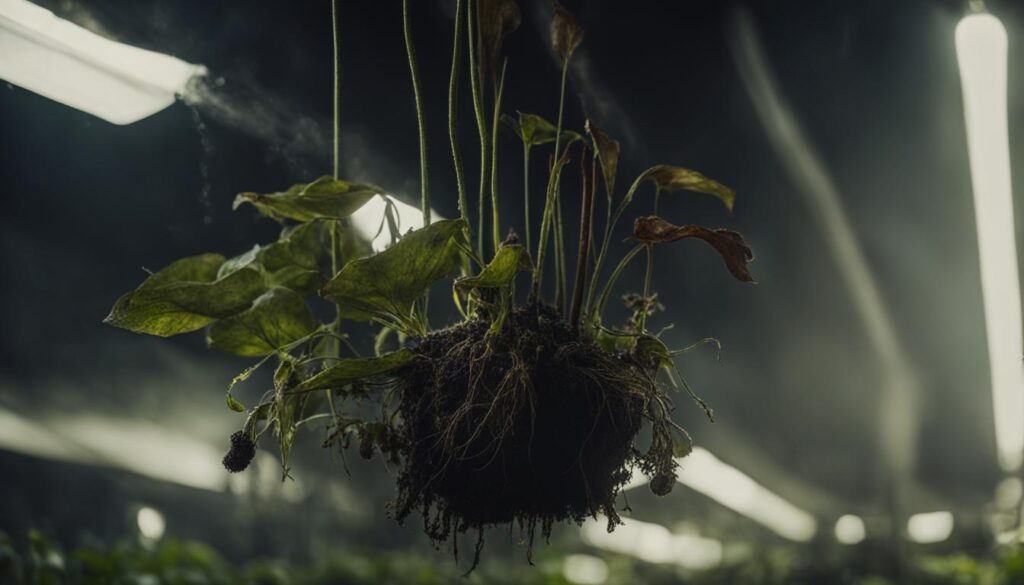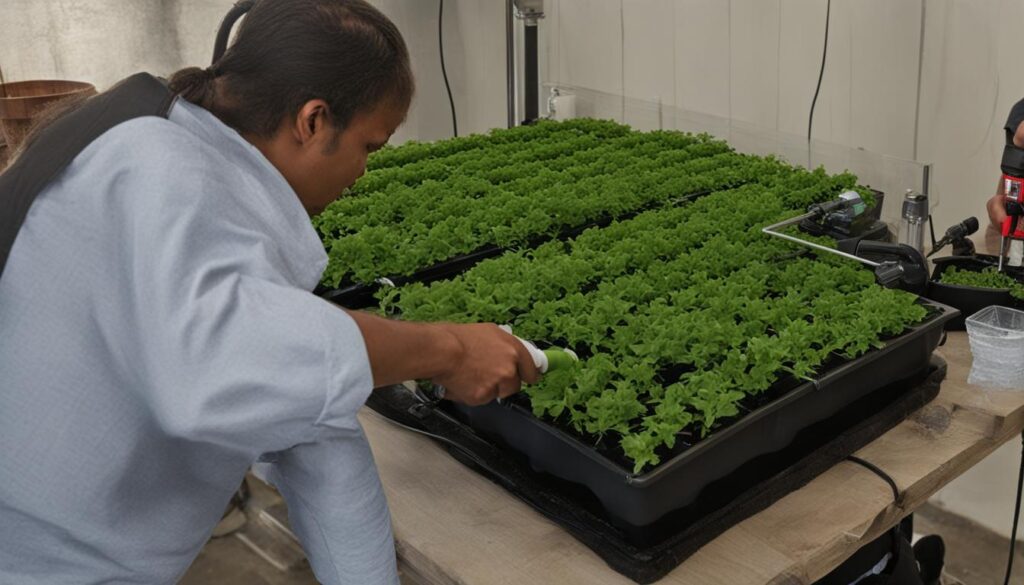Are you interested in exploring an efficient and simple way to grow plants without soil? Wick hydroponic systems could be the solution you’ve been searching for. In this article, we will delve into the pros and cons of wick system hydroponics, giving you a comprehensive understanding of this innovative growing method.
Post Summary
- Wick hydroponic systems utilize wicks to deliver nutrient-rich water directly to plant roots.
- Advantages include easy setup, versatility in location, and reliability during power outages.
- Disadvantages include potential nutrient delivery inefficiency and increased susceptibility to pests and diseases.
- Wick systems are best suited for low-maintenance plants like herbs and lettuce.
- Setting up and maintaining a wick hydroponic system requires periodic monitoring and adjustment.
Understanding Wick Hydroponic Systems
Wick hydroponic systems are a type of hydroponics system that allows plants to grow without soil. Instead, mineral nutrient solutions are used in a water solvent, and the plant’s roots are submerged in this solution to receive their nutrients. Wick systems utilize wicks to deliver the water to the root zone, ensuring that the plants receive the necessary nutrients for optimal growth. This method has several advantages over traditional soil-based methods, including higher yields per unit area and reduced concerns about pests and weeds.
With wick hydroponic systems, plants can be grown in any location without the need for fertile soil. This makes it a versatile option for urban gardeners or those with limited outdoor space. Whether you live in an apartment or have a small backyard, you can easily set up a wick system to cultivate your favorite herbs or leafy greens.
Unlike traditional soil-based gardening, wick hydroponics eliminate the need for regular watering. The wicks continuously deliver water and nutrients to the plants’ roots, ensuring they receive a consistent and optimal supply. This not only saves time but also reduces the risk of overwatering or underwatering, which can often lead to plant stress or even death.
| Advantages | |
|---|---|
| Easy setup and use | Minimal equipment required |
| Versatile | Suitable for various locations and spaces |
| Reliable | Continues to function during power outages |
Disadvantages of Wick Hydroponic Systems
While Wick hydroponic systems have many benefits, they also have some disadvantages to consider. One major drawback is that they may be less efficient than other types of hydroponic systems when it comes to nutrient delivery. In some cases, the wicks can become clogged or saturated with water, leading to poor plant growth. This can result in slower growth rates and smaller yields compared to more advanced hydroponic methods.
Another disadvantage of Wick systems is their increased susceptibility to pests and diseases. Because the plants are in direct contact with the water and nutrient solution, they may be more prone to infestations and infections. This can require more frequent monitoring and intervention to prevent and mitigate outbreaks.
Additionally, Wick hydroponic systems require regular monitoring and adjustment to ensure that the plants receive the correct amount of water and nutrients. The wicking material may need to be replaced periodically to maintain optimal capillary action, and the nutrient solution may need to be adjusted to maintain a proper balance. This level of maintenance and attention may be more demanding compared to other hydroponic systems.
Disadvantages of Wick Hydroponic Systems Overview:
- Less efficient nutrient delivery compared to other hydroponic systems.
- Increased susceptibility to pests and diseases.
- Regular monitoring and adjustment required for optimal performance.
Despite these disadvantages, Wick hydroponic systems can still be a viable option for growing certain types of plants, especially for beginners or those with limited space. By understanding and addressing these drawbacks, gardeners can maximize the potential of Wick systems and enjoy successful hydroponic gardening experiences.
Suitable Plants for Wick Hydroponic Systems
When it comes to choosing plants for your Wick hydroponic system, there are several factors to consider. It’s important to select plants that are well-suited for this type of system, as they thrive in environments with slower water and nutrient delivery. Herbs and leafy vegetables are excellent choices for Wick systems, as they have lower water and nutrient requirements compared to larger plants. Specifically, herbs like rosemary and leafy greens like lettuce are ideal candidates for Wick hydroponics.
Herbs, such as rosemary, are known for their versatility and strong flavors. They can be easily grown in a Wick hydroponic system, providing you with a fresh supply of aromatic herbs for cooking and garnishing. Rosemary requires minimal maintenance and can thrive even with slower water and nutrient delivery.
Lettuce, on the other hand, is a leafy green that is commonly grown in hydroponic systems. It is well-suited for Wick systems as it has shallow roots and can absorb water and nutrients efficiently through the wicks. Lettuce varieties like Romaine or Butterhead are popular choices for hydroponic gardening, as they grow quickly and can be harvested multiple times.
It is worth noting that different plants may have varying water and nutrient requirements, so it’s essential to research the specific needs of each plant before deciding to grow them in a Wick hydroponic system. By carefully selecting suitable plants, you can maximize the success of your Wick system and enjoy a bountiful harvest of fresh, homegrown herbs and vegetables.
Comparison of Suitable Plants for Wick Hydroponic Systems
| Plant | Water Requirement | Nutrient Requirement | Growth Rate |
|---|---|---|---|
| Rosemary | Low | Low | Slow |
| Lettuce (Romaine) | Medium | Medium | Fast |
| Lettuce (Butterhead) | Medium | Medium | Fast |
How to Set Up a Wick Hydroponic System
Setting up a Wick hydroponic system is a straightforward process that requires a few key components. To get started, you will need a container or pot to hold your plants. Choose a size that is appropriate for the number of plants you plan to grow. It is important to ensure that the container has drainage holes to prevent waterlogging.
The next component you will need is a wicking material, such as cotton, hemp, wool, or jute. This material will act as the conduit for delivering the water to the roots of your plants. Cut the wicking material into strips and place them in the container, ensuring that they reach down into the water reservoir.
Now, you need to establish a water source for your Wick system. This can be a separate reservoir that you fill manually, or you can connect your system to an automated watering system for convenience. Ensure that the water source is easily accessible for refilling as needed.
Finally, choose the right growing medium for your plants’ root systems. This can be soil, gravel, vermiculite, or any other suitable medium. The growing medium should provide support for the plants while allowing the wicking material to draw water from the reservoir.
Wick Hydroponic System Setup Components
| Component | Description |
|---|---|
| Container or Pot | Choose a suitable size with drainage holes for your plants. |
| Wicking Material | Cut strips of cotton, hemp, wool, or jute to deliver water to the roots. |
| Water Source | Set up a reservoir that can be manually refilled or connected to an automated watering system. |
| Growing Medium | Choose soil, gravel, vermiculite, or another medium to support the plants’ roots. |
With these components in place, you can now set up your Wick hydroponic system. Follow the instructions provided with your chosen wicking material and growing medium to ensure optimal setup and plant growth. Regularly monitor the water level in the reservoir and refill as needed to maintain proper hydration for your plants. With proper maintenance and care, your Wick system will provide a reliable and efficient method of growing plants hydroponically.
Tips for Maintaining a Wick Hydroponic System
Proper maintenance is crucial for the success of your Wick hydroponic system. By following these tips, you can ensure that your system operates efficiently and your plants thrive.
1. Periodic Monitoring and Adjustment: Regularly monitor the water and nutrient levels in your system. Check the wicks to make sure they are not clogged or saturated with water, as this can hinder nutrient delivery. Adjust the levels as needed to maintain the optimal balance.
2. Nutrient Balance: It’s important to maintain the correct balance of nutrients in your reservoir. Periodically check the nutrient solution to ensure that it is providing the necessary elements for your plants’ growth. Make adjustments as necessary to prevent nutrient deficiencies or excesses.
3. Refresh the Water: Regularly refresh the water in your reservoir to prevent the buildup of impurities and maintain optimal nutrient levels. This will help ensure that your plants receive clean and nutrient-rich water.
4. Pest and Disease Control: Wick hydroponic systems are more susceptible to pests and diseases because the plants are in direct contact with the water. Implement preventive measures such as keeping your system clean, practicing good hygiene, and regularly inspecting your plants for signs of infestation or disease.
By following these maintenance tips, you can enjoy a thriving Wick hydroponic system and healthy plants.
Conclusion
After weighing the pros and cons of Wick hydroponic systems, it is clear that they offer several advantages for those interested in growing plants without soil. The ease of setup and use make them an attractive option, especially for beginners or individuals with limited space. Additionally, the versatility of Wick systems allows them to be used in various locations, accommodating different gardening needs.
However, it is important to consider the potential disadvantages as well. While Wick systems are reliable, they may be less efficient when it comes to nutrient delivery compared to other hydroponic systems. This can impact the growth and overall health of your plants. Additionally, the direct contact with water and nutrient solutions may increase the susceptibility to pests and diseases, requiring extra vigilance in monitoring and care.
Ultimately, the decision to use a Wick hydroponic system depends on your specific needs and preferences as a gardener. If simplicity and space-saving are top priorities, a Wick system can be a great choice. However, if maximizing nutrient efficiency and minimizing the risk of pests and diseases are more important to you, exploring other hydroponic system options may be worth considering.
Remember to assess the water and nutrient requirements of your chosen plants, as Wick systems are best suited for low-maintenance varieties like herbs and lettuces. With proper maintenance and care, a Wick system can provide successful results and a fulfilling gardening experience.
Related Articles
If you’re interested in learning more about hydroponic systems, here are some related articles that you may find helpful:
1. Choosing the Right Hydroponic System for Your Needs
In this article, you’ll discover the different types of hydroponic systems available and how to determine which one is best suited for your specific needs. Whether you’re looking for a compact system for limited space or a high-yield system for commercial production, this guide will help you make an informed decision.
2. Hydroponic System Setup: A Step-by-Step Guide
Setting up a hydroponic system can seem overwhelming, but this comprehensive guide breaks down the process into easy-to-follow steps. From selecting the right growing medium to installing the necessary equipment, you’ll learn everything you need to know to successfully set up your own hydroponic system.
3. The Characteristics of Successful Hydroponic Systems
What makes a hydroponic system successful? This article delves into the key characteristics that contribute to the effectiveness and productivity of hydroponic systems. Learn about factors such as nutrient balance, lighting requirements, and temperature control, and discover how to optimize your system for maximum plant growth and yield.
By reading these articles, you’ll gain a deeper understanding of hydroponic systems, their setup process, and the characteristics that make them successful. Armed with this knowledge, you’ll be well-equipped to start your own hydroponic gardening journey and enjoy the benefits of growing plants without soil.
Resources for Setting Up Wick Hydroponics System
If you’re interested in setting up a Wick hydroponic system, you’ll need a few essential products to get started. Fortunately, you can easily find these items through various online retailers like Amazon. Here are some product links to help you find what you need:
1. Hydroponic Medium
To support your plants’ root systems, you’ll need a suitable hydroponic medium. Options include soil, gravel, or vermiculite. Choose the medium that best suits your specific plant requirements.
2. Plant Pots
Invest in high-quality plant pots that can hold the plants and the wicking material securely. Look for durable pots that provide adequate drainage and space for the plants to grow.
3. Wick Material
The wick material is an essential component of the Wick hydroponic system. Consider using materials like cotton, hemp, wool, or jute for effective water transfer. Choose a wick material that is absorbent and can deliver water to the roots consistently.
4. Organic Nutrients
To provide your plants with the necessary nutrients, consider using organic nutrient solutions designed for hydroponic systems. These solutions can help optimize plant growth and overall health.
By purchasing these products, you’ll have everything you need to set up your Wick hydroponic system successfully. Remember to carefully follow the instructions provided with each product to ensure optimal results.
What are the advantages and disadvantages of using a deep water culture system in comparison to a wick system in hydroponics?
When comparing deep water culture pros and cons to a wick system in hydroponics, one advantage of deep water culture is its ability to support larger plants with a more stable root system. However, a disadvantage is the need for constant monitoring and maintenance to prevent potential issues with water oxygen levels and root rot.
FAQ
What is a Wick hydroponic system?
A Wick hydroponic system is a type of hydroponics system that uses wicks to deliver nutrient-rich water directly to the roots of plants, allowing them to grow without soil.
What are the advantages of using a Wick hydroponic system?
The advantages include ease of setup and use, versatility in terms of location, and reliability even during power outages.
Are there any disadvantages to using a Wick hydroponic system?
Yes, potential disadvantages include nutrient delivery inefficiency and increased susceptibility to pests and diseases.
What types of plants are suitable for Wick hydroponic systems?
Low-maintenance plants like herbs and leafy vegetables are ideal for Wick systems.
How do I set up a Wick hydroponic system?
You will need a container or pot for the plants, a suitable wicking material, and a water source. The wicking material will deliver water to the plants’ roots via capillary action.
How do I maintain a Wick hydroponic system?
Regular monitoring and adjustment of water and nutrient levels, checking for clogged or saturated wicks, and maintaining the right nutrient balance are important for proper maintenance.












